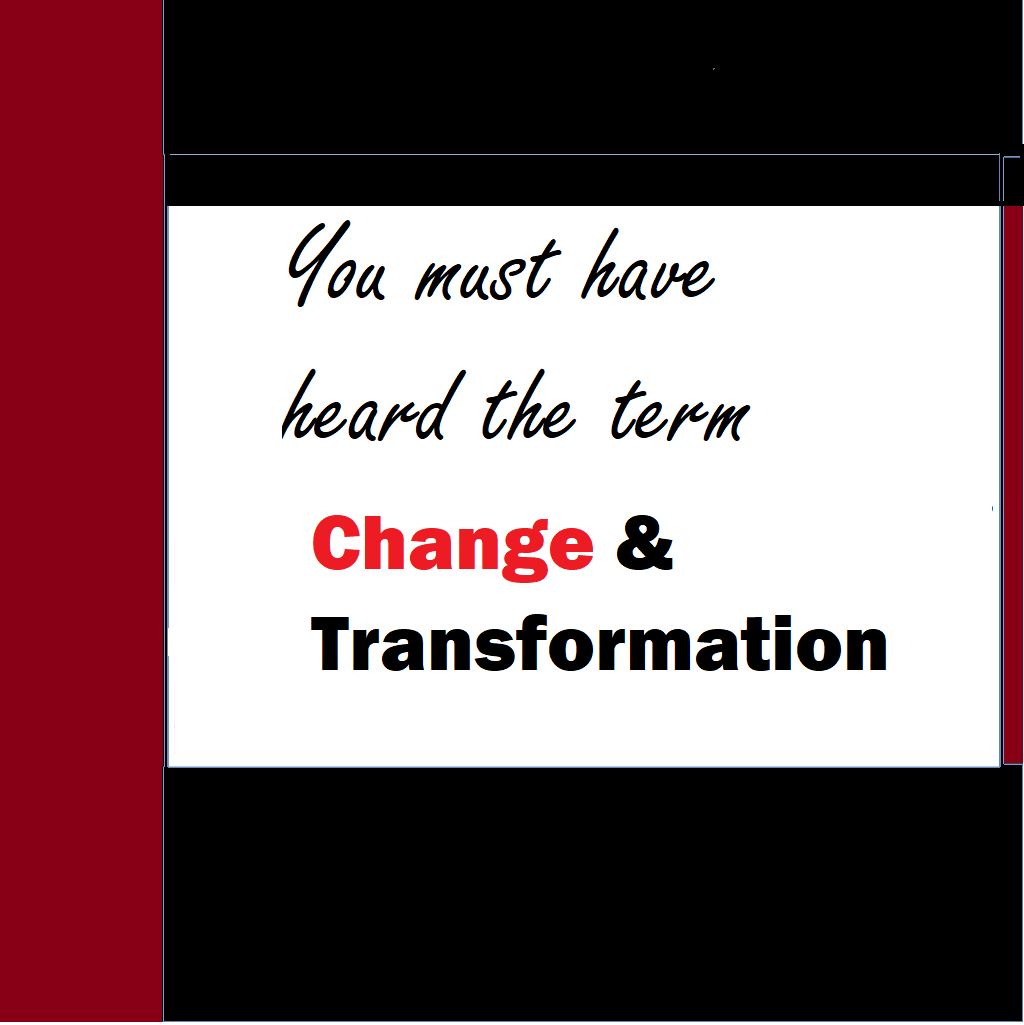This is the buzz word in IT industry these days. Someone in every company is designated as ‘Manager Change & Transformation’, now what does that exactly mean? Have you encountered this word in your organization? What role does this person play? Let’s try to find all these answers in this article. Change and transformation are related concepts that involve the alteration or modification of something, but they differ in their scope and depth.
The history of change and transformation is deeply intertwined with the evolution of human societies and the progress of civilization. While change and transformation have been ongoing throughout history, I will provide a brief overview of significant historical periods and examples of change and transformation:
1. Agricultural Revolution: Around 10,000 BCE, the transition from hunter-gatherer societies to settled farming communities marked a significant change and transformation. The development of agriculture brought about changes in human lifestyles, including the domestication of plants and animals, the establishment of permanent settlements, and the shift to a more sedentary way of life.
2. Industrial Revolution: The Industrial Revolution, which began in the late 18th century, was a transformative period characterized by significant advancements in manufacturing, technology, and transportation. The introduction of steam power, mechanization, and factory systems revolutionized industries such as textiles, mining, and transportation. This transformation had profound social, economic, and cultural effects, leading to urbanization, the rise of the middle class, and the transition from agrarian economies to industrialized nations.
3. Technological Revolution: The 20th and 21st centuries have witnessed rapid advancements in technology, leading to transformative changes across various sectors. The advent of electricity, the rise of computers, the Internet, and digital technologies have reshaped industries, communication, and daily life. This technological revolution has brought about transformations in areas such as transportation, healthcare, communication, and entertainment, fundamentally changing how people live and work.
4. Social and Cultural Revolutions: Throughout history, there have been numerous social and cultural revolutions that have sparked significant changes and transformations. Examples include the American Revolution and the French Revolution, which brought about political and social transformations, such as the establishment of democratic governments and the assertion of individual rights. The civil rights movement, women’s suffrage, and LGBTQ+ rights movements are other examples of social and cultural revolutions that have led to significant societal transformations and the fight for equality and human rights.
5. Business and Organizational Transformations: Change and transformation have been constant in the business world. Companies have experienced transformative shifts in response to economic trends, market disruptions, and technological advancements. Examples include the rise of multinational corporations, the digital transformation of businesses, and the recent focus on sustainability and corporate social responsibility.
It’s important to note that change and transformation are ongoing processes, and the pace of change has accelerated in recent times. Today, organizations and societies must continuously adapt and embrace change to thrive in a rapidly evolving global landscape. The history of change and transformation provides valuable insights into the progress of humanity and the constant need to adapt, innovate, and reshape the world we live in.
Change refers to the process of moving from one state or condition to another. It often involves a shift in circumstances, situations, or elements without necessarily implying a fundamental or profound shift in the essence or nature of the thing being changed. Change can be gradual or sudden, and it can occur in various aspects of life, such as personal, social, organizational, or environmental.
On the other hand, transformation implies a more profound and comprehensive change. It involves a fundamental shift or metamorphosis in the nature, form, or structure of something, resulting in a significant and lasting alteration. Transformation often involves a complete re-evaluation, reorganization, or reconfiguration of the entity undergoing the transformation. It encompasses a holistic and systemic change that affects multiple dimensions and aspects of the object or system.
In essence, change typically refers to a shift or modification in specific aspects, while transformation implies a more profound and comprehensive alteration that affects the core and essence of something, often resulting in a qualitative difference. Transformation implies a more extensive and impactful change compared to regular change.
What it means
In the context of Information Technology (IT), change and transformation take on specific meanings: Below are the two major aspects that we must keep in mind.
1. IT Change: IT change refers to the implementation of modifications or updates to IT systems, infrastructure, processes, or applications. It involves introducing alterations to specific components or elements within the IT environment while aiming to improve efficiency, functionality, or security. IT change can include software updates, hardware upgrades, network configurations, or changes to IT policies and procedures. The focus is typically on incremental adjustments rather than a complete overhaul of the IT system.
2. IT Transformation: IT transformation, on the other hand, refers to a more comprehensive and strategic approach to reshaping an organization’s IT capabilities. It involves a fundamental reimagining and reengineering of the entire IT landscape, including systems, processes, people, and culture. IT transformation is driven by a desire to achieve significant and long-lasting improvements in IT capabilities, agility, innovation, and alignment with business goals. It often includes initiatives such as migrating to cloud-based infrastructure, adopting new technologies, implementing DevOps practices, or reorganizing IT departments to enable digital transformation.
While IT change focuses on making specific adjustments within the existing IT framework, IT transformation encompasses a broader vision of reshaping the entire IT ecosystem to achieve strategic objectives and drive organizational growth and competitiveness. IT transformation involves more extensive planning, stakeholder involvement, and a holistic approach to reimagine how IT can support and enable business objectives in the long term.
Roles and responsibilities
In the IT industry, change and transformation leaders play crucial roles in driving and overseeing the successful implementation of change and transformation initiatives. Here are some key roles and responsibilities of change and transformation leaders in the IT industry:
- Strategic Planning: Change and transformation leaders are responsible for developing a clear vision and strategy for IT change and transformation initiatives. They align these initiatives with the organization’s overall strategic goals and objectives. This involves understanding the current IT landscape, identifying areas for improvement, and defining a roadmap for change and transformation.
- Change Management: Change and transformation leaders are skilled in change management methodologies and practices. They design and implement effective change management plans, including stakeholder engagement, communication strategies, and training programs. They help manage resistance to change, address employee concerns, and create a supportive environment for embracing and adopting new technologies, processes, or systems.
- Project Management: Change and transformation leaders oversee the planning, execution, and monitoring of change and transformation projects. They define project scopes, set milestones, allocate resources, and manage budgets. They ensure that projects are delivered on time, within budget, and with the desired outcomes. They coordinate and collaborate with various stakeholders, including IT teams, business units, vendors, and external partners.
- Technology Expertise: Change and transformation leaders possess a deep understanding of IT technologies, trends, and best practices. They stay updated with emerging technologies and assess their potential for driving change and transformation. They provide insights and recommendations on technology selection, implementation approaches, and integration strategies to ensure effective and sustainable transformations.
- Collaboration and Leadership: Change and transformation leaders foster collaboration and build strong relationships with stakeholders at all levels of the organization. They collaborate with IT teams, business leaders, executives, and employees to create a shared vision and commitment to change. They lead and inspire cross-functional teams, promoting a culture of innovation, continuous improvement, and agility.
- Risk Management: Change and transformation leaders identify and mitigate risks associated with change and transformation initiatives. They assess potential impacts on operations, data security, compliance, and other critical areas. They develop risk mitigation strategies, contingency plans, and monitor progress to ensure successful outcomes and minimize disruptions.
- Performance Measurement: Change and transformation leaders establish key performance indicators (KPIs) and metrics to track the progress and effectiveness of change and transformation initiatives. They conduct regular assessments and evaluations to measure the impact of changes, identify areas for improvement, and make necessary adjustments to achieve desired outcomes.
It’s easy to say that, change and transformation leaders in the IT industry play a pivotal role in driving and managing the complex process of change and transformation. They bring together strategic vision, change management expertise, technical knowledge, leadership skills, and a focus on delivering tangible and sustainable results.
Scope and need of change and transformation in industry
Change and transformation are essential for companies in order to remain competitive, adapt to evolving market conditions, and drive innovation. The need for change and transformation arises from various factors, including technological advancements, shifts in customer expectations, market disruptions, regulatory changes, and organizational inefficiencies. By embracing change and undertaking transformation initiatives, companies can unlock numerous benefits and opportunities.
One primary need for change and transformation is to enhance operational efficiency. Companies often face challenges related to outdated systems, manual processes, or siloed departments that hinder productivity and agility. By implementing changes in technology, process optimization, and organizational structure, companies can streamline operations, automate tasks, and eliminate bottlenecks. This leads to improved efficiency, reduced costs, faster time-to-market, and increased competitiveness.
Another key driver for change and transformation is the need to adapt to a rapidly evolving market landscape. Consumer preferences, market trends, and industry dynamics are constantly changing. To remain relevant and meet customer demands, companies must embrace change. This may involve introducing new products or services, leveraging emerging technologies, entering new markets, or repositioning their brand. Transformation initiatives enable companies to adapt their strategies, business models, and operations to stay ahead in a dynamic market.
Furthermore, change and transformation are necessary to foster innovation and drive business growth. In today’s fast-paced business environment, companies must continuously innovate to differentiate themselves and seize new opportunities. By embracing change, companies can create a culture of innovation, encourage experimentation, and empower employees to contribute their ideas. Transformation initiatives often focus on fostering a more agile and entrepreneurial mindset, enabling companies to respond quickly to market changes, identify emerging trends, and develop innovative solutions.
Change and transformation also play a vital role in addressing organizational challenges and driving cultural shifts. Companies sometimes face resistance to change, siloed departments, or a lack of collaboration and communication. Through transformation initiatives, companies can foster a culture of openness, collaboration, and continuous learning. This includes promoting effective communication, empowering employees, breaking down silos, and nurturing a growth mindset. Such cultural transformations contribute to improved employee engagement, retention, and overall organizational performance.
In a nutshell, the scope of change and transformation in a company is broad and multi-faceted. It encompasses areas such as operational efficiency, market adaptation, innovation, and cultural shifts. By embracing change and transformation, companies can gain a competitive edge, improve customer experiences, drive growth, and create a more resilient and future-ready organization. It requires strong leadership, strategic planning, effective change management, and a willingness to embrace new ideas and approaches. Ultimately, change and transformation are essential for companies that aspire to thrive in a dynamic and ever-changing business landscape.
Hierarchy of operational roles
In the IT industry, change and transformation initiatives involve various operational roles that work together to plan, implement, and manage the transformation process. The hierarchy of operational roles in change and transformation within the IT industry can be structured as follows:
- Change and Transformation Manager/Director: At the top of the hierarchy is the Change and Transformation Manager or Director. This role is responsible for leading the overall change and transformation strategy, vision, and planning. They oversee the entire process, coordinate with stakeholders, and ensure the successful execution of transformation initiatives. They provide strategic guidance, manage resources, and monitor the progress and outcomes of the transformation efforts.
- Project Manager: The Project Manager plays a crucial role in the implementation of specific change and transformation projects. They are responsible for planning, organizing, and executing the project within the defined scope, timeline, and budget. Project Managers work closely with various teams and stakeholders to ensure project objectives are met. They monitor progress, manage risks, resolve issues, and communicate project status to the Change and Transformation Manager.
- Change Management Specialist: Change Management Specialists are focused on managing the people side of change. They develop change management strategies, communication plans, and training programs to ensure smooth adoption of new processes, technologies, or systems. They work closely with stakeholders to understand their concerns, address resistance, and facilitate organizational readiness for the change. Change Management Specialists provide guidance, support, and resources to help employees transition successfully through the transformation process.
- Technical Architect/IT Infrastructure Specialist: Technical Architects or IT Infrastructure Specialists play a crucial role in the technical aspects of change and transformation initiatives. They assess the current IT infrastructure, identify gaps, and design the target architecture to support the transformation goals. They work with the project team to plan and implement changes to hardware, software, networks, and systems. Technical Architects ensure that the new IT environment aligns with the organization’s objectives and supports future scalability, security, and performance.
- Business Analyst: Business Analysts are responsible for analyzing and documenting the business requirements and processes impacted by the change and transformation initiatives. They work closely with stakeholders to gather information, identify needs, and define the desired outcomes. Business Analysts collaborate with the project team to translate business requirements into technical specifications, ensuring that the implemented changes align with the business goals and objectives.
- Testing and Quality Assurance Specialists: Testing and Quality Assurance Specialists focus on validating and ensuring the quality of the changes introduced during the transformation process. They design and execute test plans, conduct system testing, and identify and resolve any defects or issues. Testing and Quality Assurance Specialists collaborate with the project team to verify that the implemented changes meet the defined requirements, are stable, and function as intended.
These operational roles work collaboratively to execute change and transformation initiatives within the IT industry. The hierarchy reflects the different areas of expertise and responsibilities necessary to drive successful transformations, considering both technical and people-related aspects of change management. Effective coordination and communication among these roles are crucial for achieving the desired outcomes of the change and transformation efforts.
Immediate and long term benefits
Change and transformation initiatives in organizations bring both immediate and long-term benefits. Let’s explore the immediate and long-term benefits of change and transformation:
Immediate Benefits:
1. Increased Efficiency and Productivity: Change and transformation initiatives often involve process optimization, automation, and the adoption of new technologies. These changes can lead to immediate improvements in operational efficiency, reducing manual efforts and increasing productivity.
2. Cost Savings: By streamlining processes, eliminating redundancies, and leveraging technology advancements, organizations can achieve cost savings in the short term. These savings may result from reduced labor costs, optimized resource utilization, or the consolidation of systems and infrastructure.
3. Enhanced Customer Experience: Change and transformation initiatives focused on customer-centricity can deliver immediate benefits in terms of improved customer experiences. By leveraging data-driven insights, organizations can personalize interactions, provide faster and more accurate services, and address customer pain points.
4. Competitive Advantage: Swiftly adapting to market changes through change and transformation efforts can provide an immediate competitive advantage. Organizations that embrace change and proactively respond to evolving customer needs or industry trends are better positioned to outperform competitors.
Long-Term Benefits:
1. Business Growth and Innovation: Change and transformation initiatives pave the way for long-term business growth and innovation. By embracing new technologies, reimagining business models, and fostering a culture of innovation, organizations can unlock new revenue streams, enter new markets, and differentiate themselves in the long run.
2. Agility and Adaptability: Organizations that undergo change and transformation are more likely to develop an agile and adaptable mindset. They become better equipped to navigate future disruptions, respond to market dynamics, and seize emerging opportunities swiftly.
3. Improved Decision-Making: Transformation initiatives often involve the implementation of data-driven approaches, advanced analytics, and business intelligence tools. Over time, these initiatives lead to improved data management and analytics capabilities, enabling organizations to make more informed, strategic decisions.
4. Employee Engagement and Retention: A successful change and transformation effort involves engaging employees, fostering a supportive culture, and offering professional development opportunities. This leads to increased employee satisfaction, motivation, and retention, contributing to long-term organizational success.
5. Sustainability and Resilience: Change and transformation initiatives can drive sustainability practices, reduce environmental impact, and improve resource utilization. By embracing sustainability principles, organizations enhance their reputation, meet regulatory requirements, and build resilience against future challenges.
It’s important to note that the benefits of change and transformation can vary depending on the organization, industry, and specific initiatives undertaken. The long-term benefits are often more strategic and transformative, while the immediate benefits provide quick wins and lay the foundation for broader organizational change.






Nice blog here! Also your site loads up very fast! What host are you using? Can I get your affiliate link to your host? I wish my website loaded up as quickly as yours lol
Affiliate is our bread and butter right now here is the link Hostinger & Thanks for the kind words